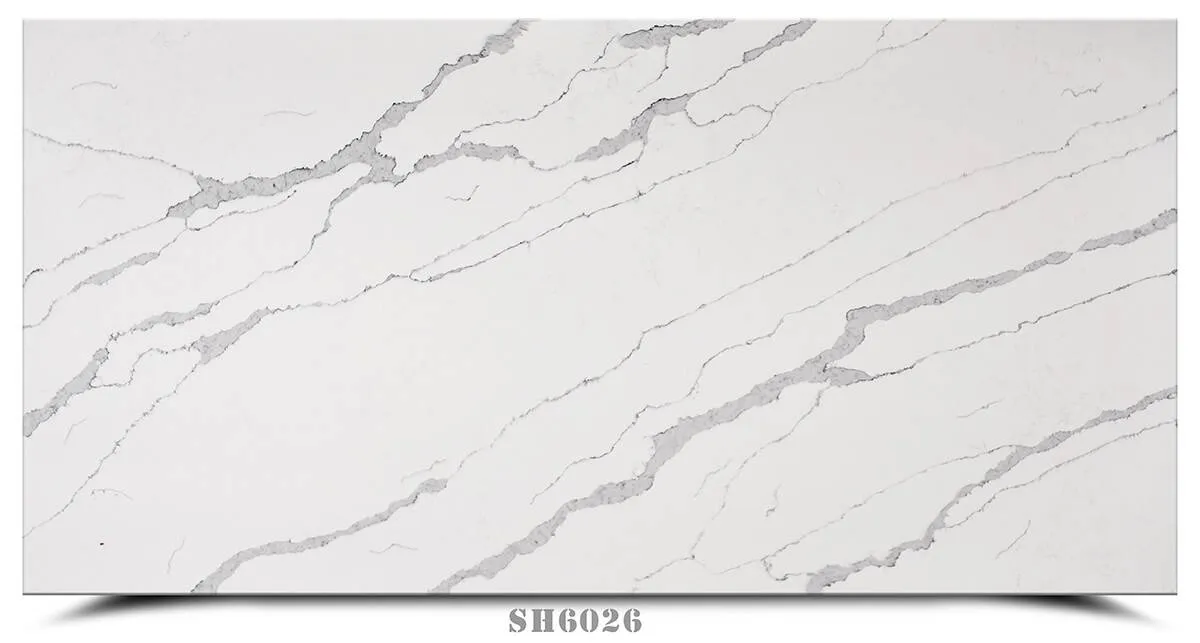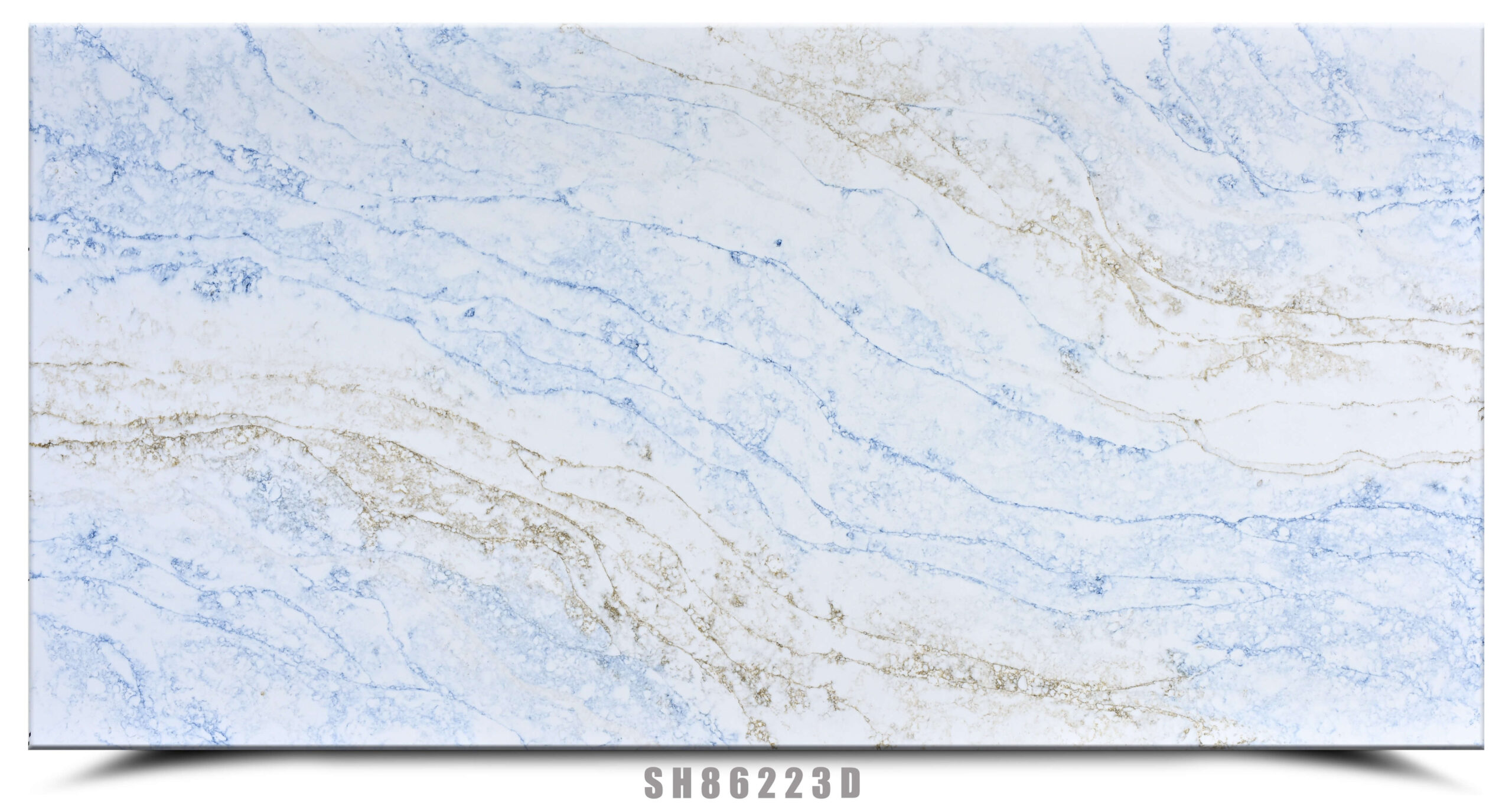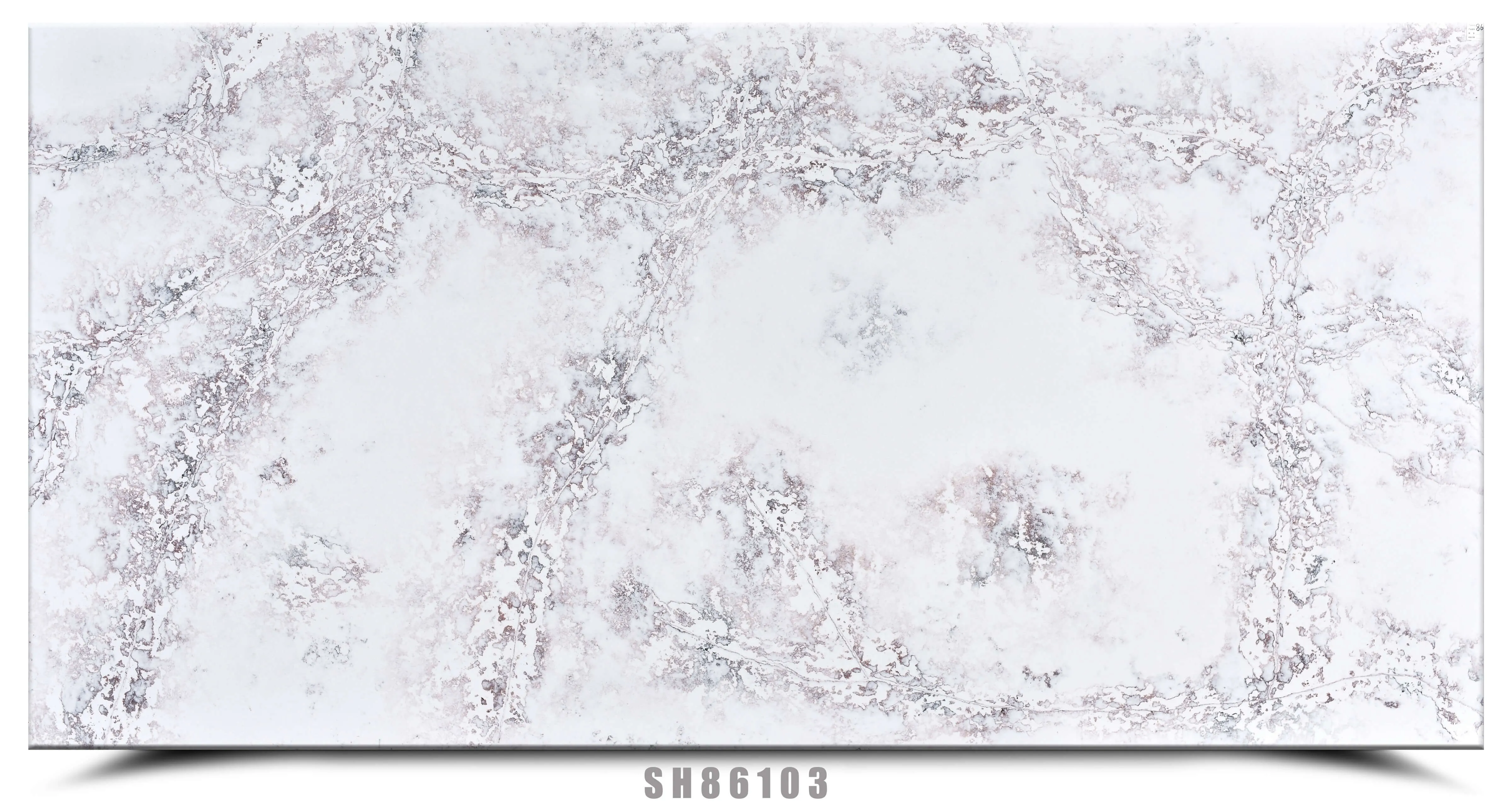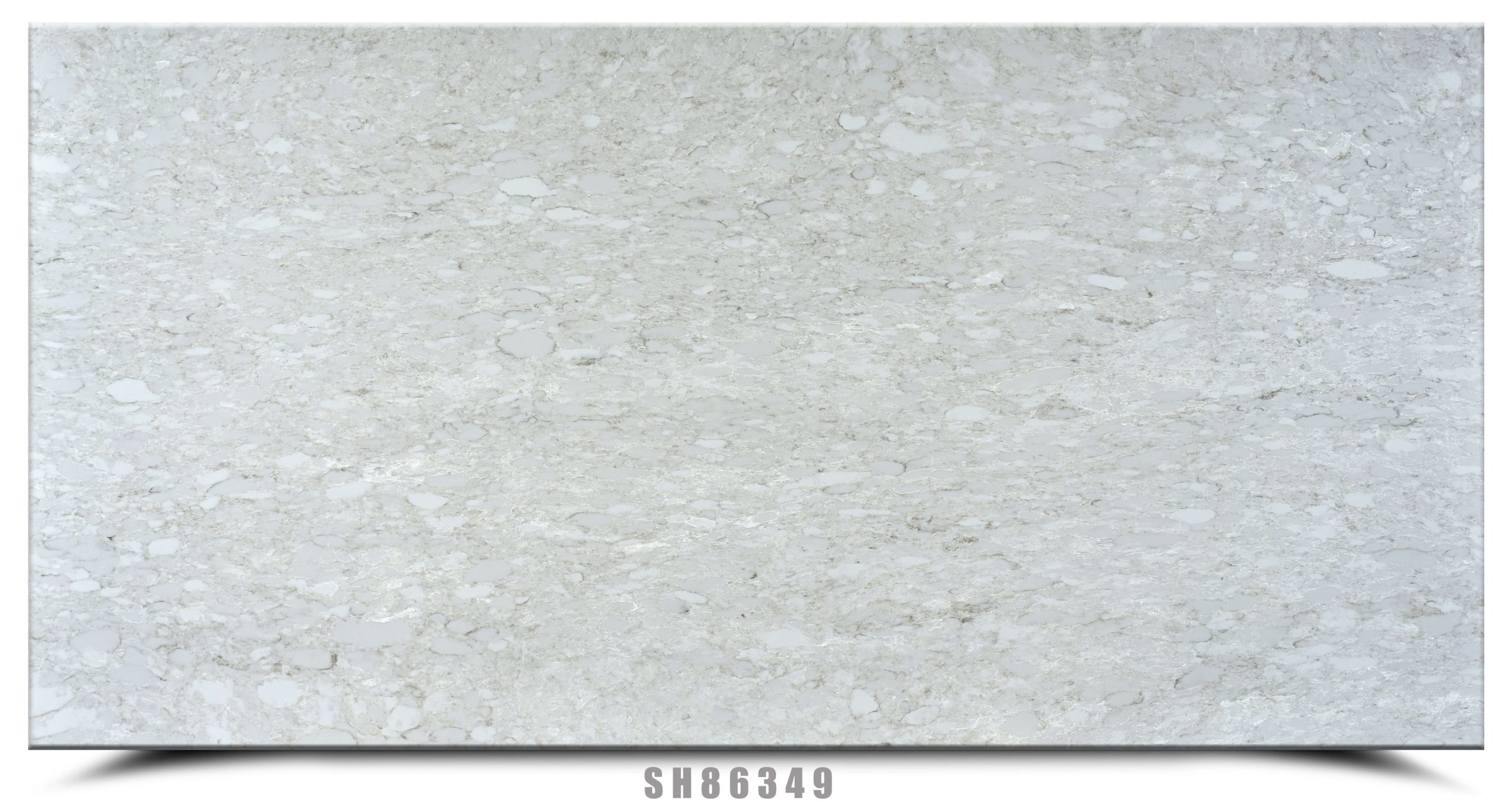advantages of quartz countertops
Artificial quartz stone, often referred to as engineered quartz or simply quartz countertops, is a popular choice for kitchen and bathroom surfaces. It is a man-made material composed of natural quartz crystals mixed with resins, polymers, and pigments. Here are some advantages of artificial quartz stone:

- Durability: Engineered quartz is known for its exceptional durability. It is highly resistant to scratches, chipping, and cracking, making it suitable for high-traffic areas like kitchens and bathrooms.
- Non-Porous: Unlike natural stones like granite and marble, artificial quartz is non-porous. This means it doesn’t absorb liquids, making it highly resistant to stains from substances like coffee, wine, and oils. It’s also less likely to harbor bacteria and mold.
- Low Maintenance: Quartz countertops require minimal maintenance. They can be easily cleaned with mild soap and water, and they don’t need sealing like natural stone surfaces do.
- Consistency: Engineered quartz is manufactured, so it is more uniform in appearance compared to natural stones. This consistency can be particularly appealing to those who prefer a clean and even aesthetic.
- Variety of Colors and Patterns: Artificial quartz is available in a wide range of colors and patterns, giving homeowners ample options to match their design preferences and existing décor.
- Heat Resistance: While extreme and direct heat exposure is not recommended, engineered quartz countertops are generally more heat-resistant than natural stones like marble. However, it’s still advisable to use trivets or hot pads to protect the surface from very hot cookware.
- Chip and Crack Resistance: The manufacturing process of engineered quartz involves binding quartz crystals with resins and polymers under high pressure. This results in a material that is less prone to chipping or cracking than natural stone options.
- Design Flexibility: Manufacturers can create engineered quartz slabs in various sizes and thicknesses, allowing for more design flexibility in terms of edge profiles and installation options.
- Environmentally Friendly: Many manufacturers are working towards producing quartz countertops with eco-friendly practices, such as recycling and reusing materials. Additionally, the durability of quartz countertops can contribute to a longer lifespan, reducing the need for replacements.
- Value: While the cost of quartz countertops can vary, they generally offer good value for their durability, low maintenance, and aesthetic appeal. They can potentially increase the resale value of a home due to their attractiveness and practicality.
Despite these advantages, it’s worth noting that there are also some considerations with artificial quartz stone. It can be more expensive than other countertop materials, and while it is highly heat-resistant, extreme and direct heat can still cause damage. Additionally, some homeowners prefer the unique beauty and variations of natural stone surfaces like granite and marble. It’s important to weigh the pros and cons based on your specific needs and preferences when considering artificial quartz stone for your countertops.
Artificial Quartz Stone Production Process
The production process of artificial quartz stone involves several stages, including mixing, molding, curing, polishing, and quality control. Here’s a general overview of the process:
1、Raw Materials Preparation:
- Quartz Crystals:Natural quartz crystals are selected and crushed into small, uniform particles. Quartz is the primary ingredient and gives the engineered stone its hardness and durability.
- Resins and Polymers:Resins, often polyester or acrylic, are used to bind the quartz particles together. These resins also provide flexibility and aid in the manufacturing process.
2、Mixing:
The crushed quartz crystals are mixed with resins, polymers, and sometimes pigments in a ratio that ensures proper binding and desired color.
3、Molding:
- The mixture is poured into molds of various sizes and shapes, depending on the intended application (countertops, tiles, etc.).
- The mixture is compacted using vibration and pressure to remove air bubbles and ensure a uniform distribution of materials.
4、Curing:
- The molded slabs or products are then placed in curing ovens. The curing process involves subjecting the material to high heat and pressure, typically around 90-100°C (194-212°F), for a certain period of time. This helps the resins harden and bind the quartz particles together.
5、Calibration and Trimming:
- After curing, the slabs are calibrated to achieve a uniform thickness. This process also involves trimming the edges to ensure straight and clean lines.
6、Polishing:
- The cured slabs are polished to achieve a glossy and smooth surface. The polishing process involves using progressively finer abrasive pads to buff the surface until it reaches the desired shine.
7、Quality Control:
- Throughout the entire production process, quality control measures are taken to ensure that the slabs meet specific standards for thickness, color consistency, and overall quality.
- Inspections are conducted to identify any defects, imperfections, or inconsistencies in the finished products.
8、Cutting and Finishing:
- Once the slabs are polished and quality-checked, they can be cut into smaller pieces or customized shapes as needed for specific projects.
- Edge profiles and other finishing touches can also be applied during this stage.
9、Packaging and Distribution:
- The finished quartz slabs or products are carefully packaged to protect them during transportation and distribution.
- They are then shipped to suppliers, distributors, and ultimately, to customers for installation.
It’s important to note that different manufacturers might have variations in their production processes, and the specifics can depend on the equipment and techniques used. Additionally, the quality of the final product can vary based on factors such as the quality of the raw materials, manufacturing techniques, and quality control procedures implemented by the manufacturer.
Quartz Slabs Cut To Sizes process
The process of cutting quartz slabs into specific sizes involves precision machinery and skilled craftsmanship. Here’s a step-by-step overview of how quartz slabs are cut to size:
1、Preparation:
- Once the artificial quartz slabs are manufactured and have undergone quality control checks, they are ready for cutting.
2、Measurement and Layout:
- The first step is to determine the required dimensions for the final pieces. This could involve measuring countertops, vanity tops, or other surfaces where the quartz will be installed.
- Based on these measurements, a layout is created to optimize the use of the quartz slab and minimize waste.
3、Marking:
- The layout is transferred onto the slab using specialized markers or templates. This ensures accurate placement of cuts, sink openings, and other necessary features.
4、Cutting:
- High-precision cutting machines, such as diamond saws or waterjet cutters, are used to cut the quartz slabs. These machines are capable of making clean and precise cuts according to the marked layout.
- For straight cuts, diamond saws equipped with diamond-tipped blades are commonly used. Waterjet cutters use a high-pressure stream of water mixed with abrasive particles to make intricate cuts and shapes.
5、Sink and Faucet Holes:
- If the quartz is being used for countertops, holes for sinks, faucets, and other fixtures are also cut using specialized tools.
- Waterjet cutters or CNC (Computer Numerical Control) machines can be used to make these precise cutouts.
6、Edge Profiling:
- Depending on the desired edge profile (e.g., beveled, rounded, ogee), the edges of the quartz pieces are shaped using specialized cutting tools or grinding equipment.
- CNC machines are often used for creating intricate edge profiles.
7、Polishing and Finishing:
- After cutting, the edges are polished to match the glossy finish of the rest of the quartz slab. Polishing pads of increasing grits are used to achieve a smooth and shiny surface.
8、Quality Control:
- Each cut and finished piece is inspected for quality, accuracy, and consistency. This ensures that the final pieces meet the required standards and specifications.
9、Packaging and Shipping:
- Once the quartz pieces have been cut, polished, and quality-checked, they are carefully packaged to prevent damage during transportation.
- The packaged pieces are then shipped to suppliers, distributors, or directly to customers for installation.
It’s important to note that the cutting process requires specialized equipment and skilled operators to ensure precision and quality. Different manufacturers may use varying methods and technologies based on their capabilities and the complexity of the project. Proper handling and cutting techniques are crucial to achieving the desired look and fit of the quartz surfaces in their intended spaces.
artificial quartz Professional QC & Packing Works
Professional quality control (QC) and packing are crucial steps in the production process of artificial quartz products to ensure that the finished items meet high standards of quality and arrive at their destination in pristine condition. Here’s how the QC and packing works are typically carried out:
Quality Control (QC) Process:
1、Initial Inspection:
As the artificial quartz slabs or products come out of the production process, an initial inspection is conducted to identify any visible defects, inconsistencies, or imperfections.
2、Dimensional Checks:
Each product is measured to ensure that it conforms to the specified dimensions, thickness, and other relevant specifications.
3、Color and Pattern Matching:
In the case of patterned or multi-color products, the QC team checks for consistency in color and pattern distribution across the surface.
4、Surface Examination:
The surface of each product is closely examined for scratches, chips, pits, or other blemishes that might affect its appearance or functionality.
5、Edge Quality:
The edges of the products are inspected to ensure that they are smooth, polished, and free from any irregularities or rough spots.
6、Fitting Tests (if applicable):
For products with cut-outs (e.g., sinks, faucets), fitting tests are conducted to ensure that fixtures fit precisely and securely.
7、Polishing Inspection:
The polishing quality of the surfaces and edges is assessed to ensure a uniform and glossy finish.
8、Water Absorption Test:
If applicable, a water absorption test may be performed to verify the non-porous nature of the material.
9、Final Approval:
Products that pass the comprehensive QC checks are approved for packing and shipment.
Packing Process:
1、Cleaning:
Before packing, the products are thoroughly cleaned to remove any dust, debris, or residues.
2、Protective Measures:
Depending on the product, protective measures might include applying a protective film or covering to the surface to prevent scratches during transportation and installation.
3、Customized Packaging:
Each product is carefully packaged based on its size, shape, and fragility. Custom packaging solutions ensure that products are adequately protected.
4、Cushioning Materials:
Cushioning materials, such as foam padding or bubble wrap, are used to create a protective barrier around the products, reducing the risk of impact damage.
5、Secure Packaging:
The packaged products are placed in sturdy cartons or crates to provide additional protection during transit.
6、Labeling:
Each package is labeled with relevant information, including product details, quantity, and handling instructions.
7、Documentation:
Proper documentation, such as packing lists and shipping labels, is prepared to accompany the shipment.
8、Quality Assurance Checks:
A final check is conducted to ensure that each package contains the correct products, and all items are securely packed.
9、Shipping:
The packaged products are loaded onto shipping containers or pallets for transportation to their intended destination.
Both the quality control and packing processes are essential to maintaining the integrity of artificial quartz products and ensuring customer satisfaction. Attention to detail, skilled workforce, and adherence to established quality standards are key elements in achieving successful QC and packing operations.
artificial quartz Seashipping Container Loading
Loading artificial quartz products into shipping containers is a crucial step to ensure the safe transportation of the goods from the manufacturing facility to their final destination. Proper loading techniques help prevent damage during transit and maximize the efficient use of container space. Here’s how the container loading process for artificial quartz products typically works:
1、Preparation:
Ensure that the artificial quartz products have undergone quality control checks, are properly packaged, and are ready for shipment.
2、Container Selection:
Choose the appropriate type and size of shipping container based on the quantity and dimensions of the products. Common container sizes include 20-foot, 40-foot, and high-cube containers.
3、Arranging Products:
Plan the arrangement of products inside the container to optimize space utilization and minimize the risk of shifting during transit.
Heavier items should be placed at the bottom, with lighter items on top to prevent crushing.
4、Palletizing:
Whenever possible, products should be placed on pallets or skids. Pallets provide stability and make it easier to load and unload the container.
5、Securing and Bracing:
Use bracing materials, such as wooden supports or dunnage, to prevent movement of products within the container. This helps avoid damage caused by shifting during transportation.
6、Cushioning and Protection:
Use cushioning materials like foam padding or bubble wrap to create a protective layer between products and the container walls. This helps prevent scratches and damage.
7、Stacking and Stabilizing:
- Stack products in a way that maintains stability and prevents items from collapsing or tipping over during transit.
- Secure each layer with strapping or bands to hold them together.
8、Even Weight Distribution:
Distribute the weight of products evenly within the container to maintain balance and prevent uneven stress on the container structure.
9、Loading Heavy Items:
If there are particularly heavy items, place them as close to the container’s floor as possible to lower the center of gravity.
10、Loading Plan:
Create a loading plan that indicates the placement of each product within the container. This helps ensure efficient loading and unloading.
11、Final Inspection:
Conduct a final inspection to make sure that all products are properly secured, cushioned, and protected.
12、Sealing and Documentation:
- Once the container is loaded and everything is in place, seal the container doors and affix any necessary seals.
- Complete the required shipping documentation, including packing lists, shipping labels, and any customs documents.
13、Container Tracking:
If available, consider using container tracking technology to monitor the container’s location and condition during transit.
14、Loading Record:
Maintain a record of the loading process, including photographs, as a reference for future shipments and quality assurance.
Proper loading practices are essential for ensuring that artificial quartz products arrive at their destination in the best possible condition. Careful planning, attention to detail, and adherence to safety guidelines contribute to successful container loading and overall logistics management.






